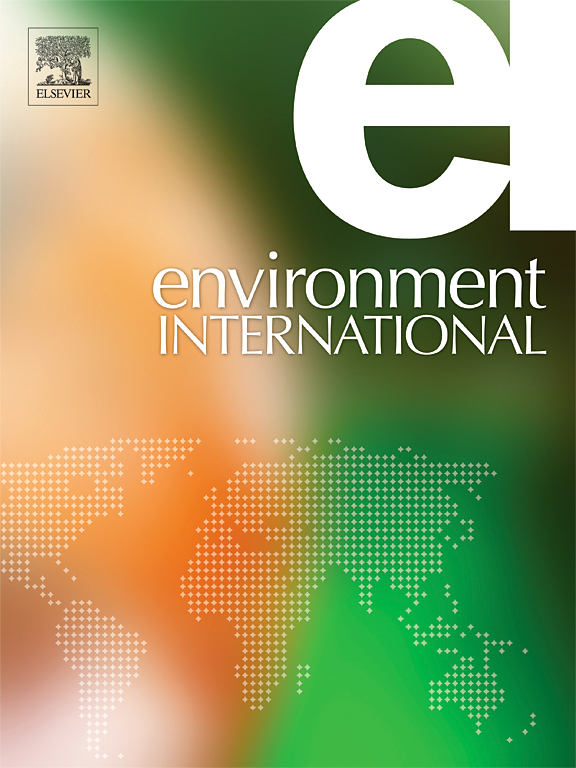层状双氧化物支撑的硫化纳米零价铁活化过硫酸盐,高效降解土壤中的 2,2′,4,4′-四溴二苯醚
IF 10.3
1区 环境科学与生态学
Q1 ENVIRONMENTAL SCIENCES
引用次数: 0
摘要
纳米零价铁(nZVI)活化过硫酸盐(PS)被认为是降解 2,2′,4,4′-四溴二苯醚(BDE-47)的有效方法。然而,所有已报道的研究都是在液体中进行的,在土壤介质中降解 BDE-47 的真实行为和微生物贡献方面的空白亟待填补。由于 BDE-47 的聚集和腐蚀,使用传统的 nZVI 作为活化剂去除 BDE-47 的效率很低。在此,我们设计了一种新型层状双氧化物支撑硫酸化纳米零价铁(S-nZVI@LDO)复合材料,并探索了 S-nZVI@LDO/PS 修复 BDE-47 污染土壤的性能。结果表明,S-nZVI@LDO 具有优异的稳定性和还原能力。结果表明,S-nZVI@LDO具有良好的稳定性和优异的还原能力,可与PS偶联实现对BDE-47的快速高效降解,6 h内的去除率达到92.31%(5 mg/kg),远高于n-ZVI/PS(53.38%)和S-nZVI/PS(75.69%)。S-nZVI@LDO/PS 降解 BDE-47 的动力学常数分别是单一 S-nZVI@LDO 和 nZVI/PS 的 23.6 倍和 3.7 倍。这归因于系统中 SO4--、-OH、O2--和 1O2 的高效产生,其中 SO4--和 -OH 占主导地位。生物信息学分析表明,S-nZVI@LDO/PS 对土壤的修复显著富集了芳香族化合物降解菌,并增加了碳氢化合物降解功能的丰度。微生物降解可能在 BDE-47 降解和土壤质量恢复中发挥重要作用。降解途径的鉴定表明,根据 GHS 毒性预测,BDE-47 通过脱溴、羟基化、中心氧裂解和开环等一系列过程降解为毒性极低的产物,甚至完全矿化。这些发现可能对利用 S-nZVI@LDO/PS Fenton-like 系统原位净化受污染土壤中的溴化阻燃剂具有重要意义。本文章由计算机程序翻译,如有差异,请以英文原文为准。
Activation of persulfate by a layered double oxide supported sulfidated nano zero-valent iron for efficient degradation of 2,2′,4,4′-tetrabromodiphenyl ether in soil
The nano zero-valent iron (nZVI) activated persulfate (PS) is recognized as a promising approach to degrade 2,2′,4,4′-tetrabromodiphenyl ether (BDE-47), which is ubiquitous in the soil at electronic waste sites. However, all the reported studies were performed in liquids, gaps in the real behaviour and microbial contribution to the degradation of BDE-47 in soil media need to be urgently filled. The removal efficiency of BDE-47 is low using traditional nZVI as activator because of its aggregation and corrosion. Herein, we designed a novel layered double oxide supported sulfidated nano zero-valent iron (S-nZVI@LDO) composite and explored the performance of S-nZVI@LDO/PS to remediate BDE-47 contaminated soil. The results showed that S-nZVI@LDO has excellent stability and superior reduction capability. It could couple PS to achieve a rapid and efficient degradation of BDE-47, and the removal efficiency reached 92.31 % (5 mg/kg) within 6 h, which was much higher than that of n-ZVI/PS (53.38 %) or S-nZVI/PS (75.69 %). The kinetic constant of BDE-47 degradation by S-nZVI@LDO/PS was 23.6 and 3.7 times higher than that by single S-nZVI@LDO and nZVI/PS, respectively. It is attributable to the efficient production of SO4•-, •OH, O2•-, and 1O2 in the system, in which SO4•- and •OH dominated. The bioinformatic analysis demonstrate that soil remediation by S-nZVI@LDO/PS significantly enriched aromatic compounds-degrading bacteria and increased the abundance of hydrocarbon degradation functions. Microbial degradation may play important roles in the BDE-47 degradation and soil quality recovery. The identification of degradation pathways suggests that BDE-47 was degraded to very low-toxic products based on GHS toxicity prediction through a series process of debromination, hydroxylation, cleavage central oxygen, and ring opening, or even completely mineralized. The findings may provide significant implications for the in-situ clean-up of brominated flame retardants in contaminated soil using S-nZVI@LDO/PS Fenton-like system.
求助全文
通过发布文献求助,成功后即可免费获取论文全文。
去求助
来源期刊

Environment International
环境科学-环境科学
CiteScore
21.90
自引率
3.40%
发文量
734
审稿时长
2.8 months
期刊介绍:
Environmental Health publishes manuscripts focusing on critical aspects of environmental and occupational medicine, including studies in toxicology and epidemiology, to illuminate the human health implications of exposure to environmental hazards. The journal adopts an open-access model and practices open peer review.
It caters to scientists and practitioners across all environmental science domains, directly or indirectly impacting human health and well-being. With a commitment to enhancing the prevention of environmentally-related health risks, Environmental Health serves as a public health journal for the community and scientists engaged in matters of public health significance concerning the environment.
 求助内容:
求助内容: 应助结果提醒方式:
应助结果提醒方式:


